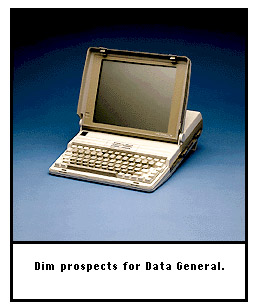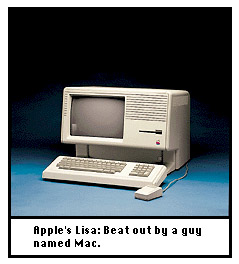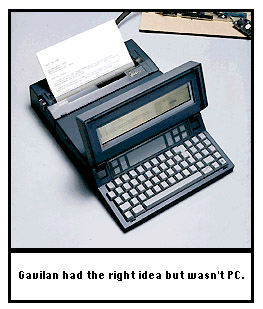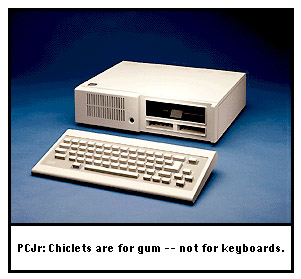| Sometimes you get it; sometimes you don't. Why should
computer companies be any different? There doesn't seem to
be a single one that has the complete Midas touch. Apple III Apple Computer Apple's first designed-for-business computer was plagued with hardware gremlins after its 1980 debut. Or perhaps gremlins isn't the right word — ogres might be more accurate. At one point, Apple advised users of malfunctioning units to lift their machine several inches off the desktop and then drop it — to reseat loose chips. The Apple III engineering group was disbanded in 1984. VisiOn VisiCorp This integrated software package had a slick windowing interface and was supposed to be the smash-hit sequel to VisiCalc, the first spreadsheet program. But two years after it appeared in 1982, VisiOn was "visioff." MSX Microsoft You think everything Microsoft touches turns to gold? Think again. MSX, a Z80-based computer standard developed with several Japanese companies in 1983, flopped so badly that only a handful of MSX machines were ever sold in the U.S. Somehow Microsoft survived. Lisa Apple Computer With 1 MB of RAM, 2 MB of ROM, a 5-MB hard drive, and the first GUI ever seen on a personal computer, the Lisa was a breakthrough machine in 1983. It cost $10,000 and crawled like a slug, however. When the Macintosh arrived in 1984 at $2495, the Lisa was doomed. In 1989, the last 2700 Lisas were buried in a Utah landfill. Aquarius Mattel When Mattel demonstrated this computer at a trade show in 1983, employees had to conceal one of the keys with masking tape. For some bizarre reason known only to Mattel engineers, the Aquarius had a convenient key that instantly rebooted the computer and wiped out all your data. DEC Rainbow Digital Equipment Corp. In the early 1980s, several companies tried to sell computers that ran MS-DOS but weren't IBM PC-compatible. One was the DEC Rainbow, which became famous as the computer that couldn't format its own floppy disks. You had to buy preformatted blank disks from DEC — at a considerable markup. The Rainbow quickly faded in 1985. Gavilan Mobile Computer Gavilan Computer Corp. This early 8088-based laptop had an eight-line LCD screen, an innovative touchpad, and an optional printer that attached to the back. But it wasn't PC-compatible and suffered from technical problems. In 1984, a Gavilan executive announced, "The microcomputer industry is entering a new chapter — Chapter 11." Adam Coleco For the incredibly low price of $599, eager buyers got a Z80-based home computer with a daisy-wheel printer, a 512-KB tape drive, and bundled software — luxurious features in 1984. But the Adam was so poorly designed that it sometimes erased its own tapes during boot-up. It was nicknamed the "Adam bomb." PCjr IBM This cruelly crippled cousin of the IBM PC was supposed to conquer the home market in 1984. Instead, it was overshadowed by Apple's launch of the Macintosh, and its chiclet keyboard and sky-high price drove away hordes of buyers. The PCjr died a laughingstock in 1985. Mindset PC Mindset Too far ahead of its time, the Mindset tried to bring dazzling color graphics to business users in 1984. Unfortunately, it wasn't completely PC-compatible, and most business users thought color graphics were for game machines. (Little did they know.) However, the Mindset became the first computer in the New York Museum of Modern Art's permanent industrial collection. DG/One Data General This 10-pound laptop had a 12-inch LCD screen, a mighty impressive feature in 1984. In theory, anyway: The nonbacklit screen was almost readable if the light was just right and you had the vision of Superman. Most people didn't. Osborne II Osborne Computer In 1984, Adam Osborne announced that he would introduce a new version of his Osborne I, the first successful portable computer. In anticipation of the Osborne II's superior features and performance, sales of the Osborne I plummeted. When the Osborne II was delayed, the company's finances plummeted. Within months, Osborne was in bankruptcy court. Jazz Lotus Development This 1985 integrated software package was supposed to turn the Mac into a whiz-bang business machine. But most reviewers said that Jazz didn't boogie, and Microsoft Excel outsold it 3 to 1. After Microsoft introduced its own integrated software, Works, Jazz sang the blues. TopView IBM Preceded by a year of hype and ballyhoo, TopView was supposed to bring multitasking to DOS programs on IBM PCs. In 1985, however, the typical PC had an 8088 or a 286 CPU with 256 to 640 KB of RAM. Hardware and compatibility problems soon dropped TopView out of sight. Windows 1.0 Microsoft This is the only spectacular failure that eventually made a comeback and became a spectacular success. Announced in 1983 and shipped in 1985, Windows 1.0 was so crude that it was mocked by Mac users and largely ignored by PC users. Not until Microsoft released version 3.0 in 1990 did Windows become a hit. Access Microsoft We're talking about the 1985 terminal program, not the 1992 relational database. Need we say more? PC Convertible IBM Reviewers weren't exactly thrilled with IBM's first laptop in 1986. IBM retailer president Jay Rosovsky responded, "So what? It's going to sell well because it says IBM and might legitimize a lap market that's been wallowing. I don't think it's technologically great shakes." He was wrong, and he was right. dBase IV Ashton-Tate Released in 1988 after long delays, dBase IV was so riddled with bugs that many users fled back to dBase III Plus. Two years later, dBase IV 1.1 finally fixed some of the bugs, but the damage was done. Borland bought Ashton-Tate in 1991 and spent three more years porting dBase to Windows. Momenta Pentop Momenta This 386-based portable pen computer could run either Windows or a proprietary GUI environment and was considered intriguing enough to make the cover of BYTE in November 1991. But it weighed 7 pounds, cost $4995, and was hobbled by poor handwriting recognition. After its shining Momenta in the sun, the company expired in 1992. OSI International Standards Organization OSI (Open Systems Interconnection) is a seven-layer reference model for network protocols that was supposed to set a new standard for interoperability. Thanks to strong backing from the federal government, it never had a chance.  Dim Prospects For Data General.
 Apple's Lisa: Beat Out By A Guy Named Mac.
 Gavilan Had The Right Idea But Wasn't PC.
 PCjr: Chiclets Are For Gum — Not For
Keyboards.
Copyright 1994-1998 BYTE |